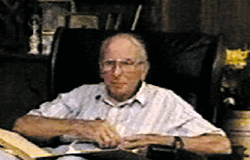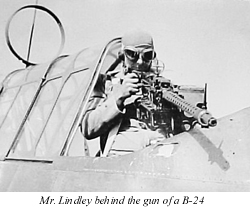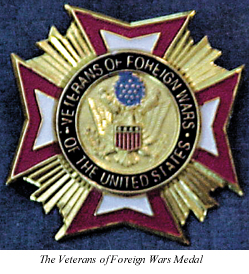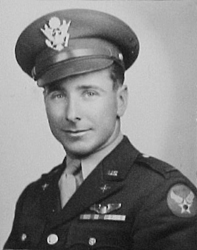|
 Mr.
Billy Lindley joined the Texas Air National Guard not long after President
Roosevelt mobilized the National Guard on August 27, 1940. After completing
his training in Oregon, Mr. Lindley joined the 111th Observational Squadron.
With the 111th he served as an air gunner on patrols of the U.S.-Mexico border.
Billy and his coworkers watched for German submarines attempting to disrupt
American trade in the Gulf of Mexico. He clearly remembers the day his role
in America’s defense was changed—the day Japan bombed Pearl Harbor. “I was
still in the State at that time . . . and I accepted a transfer from the Texas
National Guard into [pilot] training.” Mr.
Billy Lindley joined the Texas Air National Guard not long after President
Roosevelt mobilized the National Guard on August 27, 1940. After completing
his training in Oregon, Mr. Lindley joined the 111th Observational Squadron.
With the 111th he served as an air gunner on patrols of the U.S.-Mexico border.
Billy and his coworkers watched for German submarines attempting to disrupt
American trade in the Gulf of Mexico. He clearly remembers the day his role
in America’s defense was changed—the day Japan bombed Pearl Harbor. “I was
still in the State at that time . . . and I accepted a transfer from the Texas
National Guard into [pilot] training.”
 Mr.
Lindley completed pilot training in June 1943, and was sent to Florida to
begin flying B-24 bombers. He was soon sent overseas to serve as a combat
pilot with the Thirteenth Air Force, 307th bomb group, 372nd bomb squadron.
Mr. Lindley’s first mission in the Pacific was to take out a target on Rabaul.
He recalls, “Rabaul was one of the most heavily fortified islands the Japanese
had. Not only was it a harbor for their ships, but they also had an airfield
. . . oil storage, gasoline storage, food . . . so it was an ideal target.”
Billy continues, “We took a beating at first, losing many airplanes and also
crew members, but we kept pounding the target until we annihilated it. . .
. It became of no use to the Japanese and no threat to the Thirteenth Air
Force,” he proudly proclaims. Mr.
Lindley completed pilot training in June 1943, and was sent to Florida to
begin flying B-24 bombers. He was soon sent overseas to serve as a combat
pilot with the Thirteenth Air Force, 307th bomb group, 372nd bomb squadron.
Mr. Lindley’s first mission in the Pacific was to take out a target on Rabaul.
He recalls, “Rabaul was one of the most heavily fortified islands the Japanese
had. Not only was it a harbor for their ships, but they also had an airfield
. . . oil storage, gasoline storage, food . . . so it was an ideal target.”
Billy continues, “We took a beating at first, losing many airplanes and also
crew members, but we kept pounding the target until we annihilated it. . .
. It became of no use to the Japanese and no threat to the Thirteenth Air
Force,” he proudly proclaims.
 Mr.
Lindley “had missions all up and down the coast” and numerous brushes with
death. One day while flying in a bombing formation called the “Tail End Charlie,”
Billy nearly lost his life. He explains, “Just as we got over the target and
dropped our bombs . . . we got hit in our plane and . . . lost our hydraulic
system. The hydraulic system operated the landing gear. . . . We had no alternative
but to do the best we could. . . . We had to crank the nose wheel down manually.”
Mr. Lindley and the crew safely returned to the base because the plane was
equipped with a self-sealing gas tank and lost no fuel. Mr.
Lindley “had missions all up and down the coast” and numerous brushes with
death. One day while flying in a bombing formation called the “Tail End Charlie,”
Billy nearly lost his life. He explains, “Just as we got over the target and
dropped our bombs . . . we got hit in our plane and . . . lost our hydraulic
system. The hydraulic system operated the landing gear. . . . We had no alternative
but to do the best we could. . . . We had to crank the nose wheel down manually.”
Mr. Lindley and the crew safely returned to the base because the plane was
equipped with a self-sealing gas tank and lost no fuel.
After
flying nearly fifty missions, Mr. Lindley was relieved of combat duty. During
his former crew’s first flight without him, “they went into a cloud bank.”
He continues, “When they broke through . . . they were in a head-on collision.
The B-24s blew up and, of course, all twenty men were killed.” Mr. Lindley
sadly notes, “These were the tragedies of war as we experienced it, as we
saw it. It was a terrible thing.”
 When
Billy Lindley completed his combat duty, he returned to the U.S. and became
a B-24 flight instructor. He also ferried planes from San Antonio to Boca
Raton, Florida and earned the rank of First Lieutenant. As an officer, Mr.
Lindley tried to treat the enlisted men with respect and generosity. He recalls
the thrill he felt when permitted to fly a plane as an untrained enlisted
man. “It gave me [the] enthusiasm to become a pilot, and I did so.” Billy
tried to give his crew members “a little stick time” during routine flights
with the hope that they would be inspired, just as he was. When
Billy Lindley completed his combat duty, he returned to the U.S. and became
a B-24 flight instructor. He also ferried planes from San Antonio to Boca
Raton, Florida and earned the rank of First Lieutenant. As an officer, Mr.
Lindley tried to treat the enlisted men with respect and generosity. He recalls
the thrill he felt when permitted to fly a plane as an untrained enlisted
man. “It gave me [the] enthusiasm to become a pilot, and I did so.” Billy
tried to give his crew members “a little stick time” during routine flights
with the hope that they would be inspired, just as he was.
|


 Mr.
Billy Lindley joined the Texas Air National Guard not long after President
Roosevelt mobilized the National Guard on August 27, 1940. After completing
his training in Oregon, Mr. Lindley joined the 111th Observational Squadron.
With the 111th he served as an air gunner on patrols of the U.S.-Mexico border.
Billy and his coworkers watched for German submarines attempting to disrupt
American trade in the Gulf of Mexico. He clearly remembers the day his role
in America’s defense was changed—the day Japan bombed Pearl Harbor. “I was
still in the State at that time . . . and I accepted a transfer from the Texas
National Guard into [pilot] training.”
Mr.
Billy Lindley joined the Texas Air National Guard not long after President
Roosevelt mobilized the National Guard on August 27, 1940. After completing
his training in Oregon, Mr. Lindley joined the 111th Observational Squadron.
With the 111th he served as an air gunner on patrols of the U.S.-Mexico border.
Billy and his coworkers watched for German submarines attempting to disrupt
American trade in the Gulf of Mexico. He clearly remembers the day his role
in America’s defense was changed—the day Japan bombed Pearl Harbor. “I was
still in the State at that time . . . and I accepted a transfer from the Texas
National Guard into [pilot] training.”  Mr.
Lindley completed pilot training in June 1943, and was sent to Florida to
begin flying B-24 bombers. He was soon sent overseas to serve as a combat
pilot with the Thirteenth Air Force, 307th bomb group, 372nd bomb squadron.
Mr. Lindley’s first mission in the Pacific was to take out a target on Rabaul.
He recalls, “Rabaul was one of the most heavily fortified islands the Japanese
had. Not only was it a harbor for their ships, but they also had an airfield
. . . oil storage, gasoline storage, food . . . so it was an ideal target.”
Billy continues, “We took a beating at first, losing many airplanes and also
crew members, but we kept pounding the target until we annihilated it. . .
. It became of no use to the Japanese and no threat to the Thirteenth Air
Force,” he proudly proclaims.
Mr.
Lindley completed pilot training in June 1943, and was sent to Florida to
begin flying B-24 bombers. He was soon sent overseas to serve as a combat
pilot with the Thirteenth Air Force, 307th bomb group, 372nd bomb squadron.
Mr. Lindley’s first mission in the Pacific was to take out a target on Rabaul.
He recalls, “Rabaul was one of the most heavily fortified islands the Japanese
had. Not only was it a harbor for their ships, but they also had an airfield
. . . oil storage, gasoline storage, food . . . so it was an ideal target.”
Billy continues, “We took a beating at first, losing many airplanes and also
crew members, but we kept pounding the target until we annihilated it. . .
. It became of no use to the Japanese and no threat to the Thirteenth Air
Force,” he proudly proclaims.  Mr.
Lindley “had missions all up and down the coast” and numerous brushes with
death. One day while flying in a bombing formation called the “Tail End Charlie,”
Billy nearly lost his life. He explains, “Just as we got over the target and
dropped our bombs . . . we got hit in our plane and . . . lost our hydraulic
system. The hydraulic system operated the landing gear. . . . We had no alternative
but to do the best we could. . . . We had to crank the nose wheel down manually.”
Mr. Lindley and the crew safely returned to the base because the plane was
equipped with a self-sealing gas tank and lost no fuel.
Mr.
Lindley “had missions all up and down the coast” and numerous brushes with
death. One day while flying in a bombing formation called the “Tail End Charlie,”
Billy nearly lost his life. He explains, “Just as we got over the target and
dropped our bombs . . . we got hit in our plane and . . . lost our hydraulic
system. The hydraulic system operated the landing gear. . . . We had no alternative
but to do the best we could. . . . We had to crank the nose wheel down manually.”
Mr. Lindley and the crew safely returned to the base because the plane was
equipped with a self-sealing gas tank and lost no fuel. When
Billy Lindley completed his combat duty, he returned to the U.S. and became
a B-24 flight instructor. He also ferried planes from San Antonio to Boca
Raton, Florida and earned the rank of First Lieutenant. As an officer, Mr.
Lindley tried to treat the enlisted men with respect and generosity. He recalls
the thrill he felt when permitted to fly a plane as an untrained enlisted
man. “It gave me [the] enthusiasm to become a pilot, and I did so.” Billy
tried to give his crew members “a little stick time” during routine flights
with the hope that they would be inspired, just as he was.
When
Billy Lindley completed his combat duty, he returned to the U.S. and became
a B-24 flight instructor. He also ferried planes from San Antonio to Boca
Raton, Florida and earned the rank of First Lieutenant. As an officer, Mr.
Lindley tried to treat the enlisted men with respect and generosity. He recalls
the thrill he felt when permitted to fly a plane as an untrained enlisted
man. “It gave me [the] enthusiasm to become a pilot, and I did so.” Billy
tried to give his crew members “a little stick time” during routine flights
with the hope that they would be inspired, just as he was.